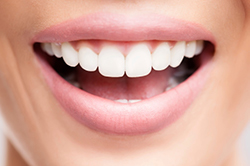South Ogden
Why We Use Gum Grafts to Replace Receded Gums

A receding gum line can affect both the appearance and health of your mouth. The gums serve to be a barrier against the mechanical effects of eating, chewing, and biting. There are many reasons the gums may start to recede, including the lack of oral hygiene.
What Causes Receding Gums?
A cause of receding gum lines can be ineffective oral hygiene. Ineffective oral hygiene can include inadequate brushing. If brushing isn’t done correctly then you may fail to remove dental plaque. Excessive brushing can also lead to receding gums by eroding the tissue. Other causes of receding gums can include foreign objects in the mouth that are rubbing against the gums. These objects can include dentures that are fitted poorly, tongue bolts, or even fingernails if you’re a frequent nail biter. After the roots of the teeth lose the healthy tissue that is protecting them, they can become sensitive, and it is then easier for bacteria to penetrate the roots and cause decay.
Treating Receding Gums With Gum Grafts
A gum graft is when our periodontist carefully places a small amount of new tissue in the area where the recession has occurred, or there is limited to no gum tissue. This is recommended to help prevent the gums from receding further, and to help cover parts that have been exposed. The tissue used in the graft often comes for the roof of the mouth and is stitched in place where it is needed. During the recovery process blood vessels grow into the tissue that was grafted and it begins to become integrated with the surrounding tissue.
Receding gum lines can affect both the appearance of your smile and the health of your mouth. If you have questions about gum grafts, or you are experiencing a receding gum line, please call our office and our periodontists can help.

